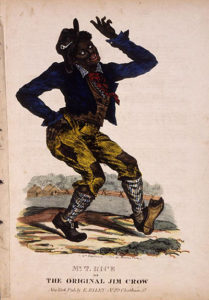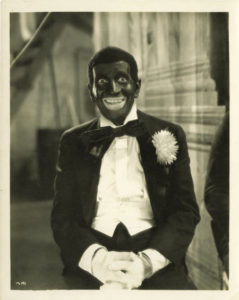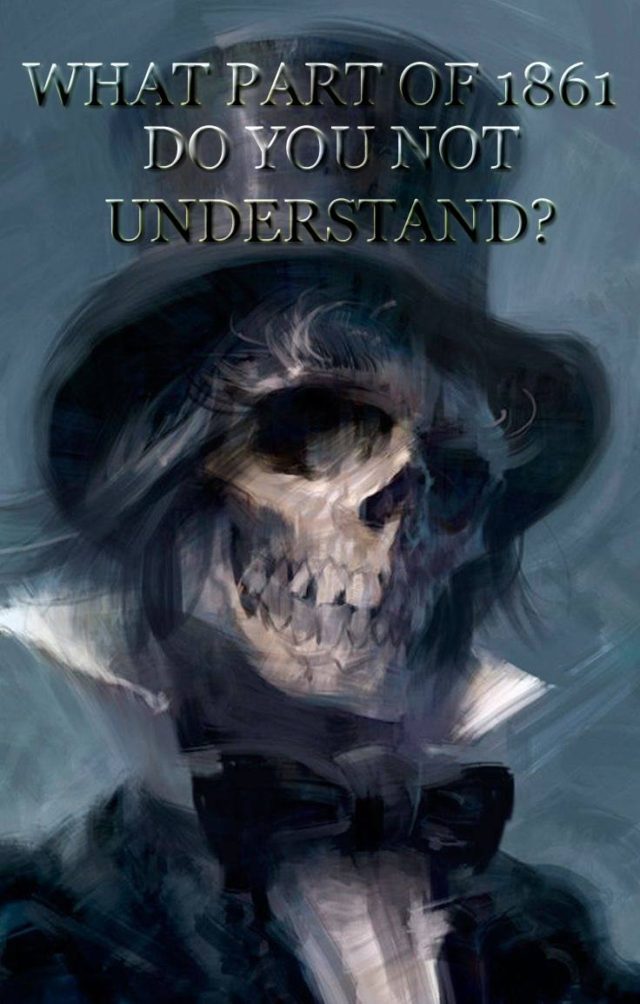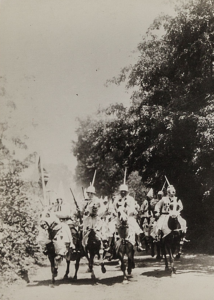~ Foreward ~
I am delighted to publish this article by Mike Scruggs, historian, author, columnist for The Times Examiner out of Greenville, South Carolina. I have Mike’s 359 page illustrated book, The Un-Civil War, Shattering the Historical Myths, which promises to be outstanding. I look forward to reviewing it in the next few weeks.

Thomas D. Rice, the original Jim Crow, in costume.
This article contains much historical detail and makes it clear why Southern states, after the horrors of Reconstruction, felt an imperative to copy the Jim Crow laws of the Northern states. Before Reconstruction, the South was integrated, by necessity, according to C. Vann Woodward in The Strange Career of Jim Crow, which produced an intimacy between blacks and whites not found anywhere else in the country. That’s not to say that race relations were always great, but they were far better in the South than in the North and the West. Blacks and whites in the South did not recoil from each other as did the white Yankee women at the end of Gone with the Wind with the thought of Mammy touching their children. Scarlett O’Hara found that absurd. That is a good case of fiction perfectly illustrating reality.
The North and West were the opposite of the South. Blacks and whites were rigidly segregated, by custom, law, or both. ~ Gene Kizer, Jr.
How Northern Jim Crow Laws Moved South
“Jim Crow” was the stage name of New York actor Thomas D. Rice (1808-1860), who made a career of minstrel performances in blackface and thus popularized that form of entertainment. The name “Jim Crow” came from a popular 1832 song, “Jump Jim Crow,” written and sung by Rice and became a common term referring to African-Americans. Later it became a nickname for legislation restricting the rights of African-Americans.

Thomas Dartmouth “Daddy” Rice, who put the term “Jim Crow” into our lexicon.
Blackface is not necessarily demeaning. Rice may have based his character on slave folk tales about a clever trickster.

Al Jolson
Al Jolson (1886-1950), a Russian Jewish immigrant, and the most popular and beloved American entertainer beginning with the movie The Jazz Singer in 1927 and lasting for many decades, was said to be the “king of blackface.” Jolson’s personal feelings and many of his songs were certainly sympathetic to African-Americans.
What most people do not know is that Jim Crow laws first originated in Northern States. Northern Jim Crow Laws were the model for Southern States following the ruin, corruption, and oppression of Reconstruction. As author C. Vann Woodward has stated, “Jim Crow has had a strange career.”
In Alexis de Toqueville’s 1835 book, Democracy in America, he wrote that “the prejudice of race appears to be stronger in the States that have abolished slavery than in those where it still exists; and nowhere is it so intolerant as in those States where servitude has never been known.”
Before the “Civil” War, most Northern States had discriminatory laws against blacks. In 1847, Ohioans prohibited the settlement of the 518 emancipated slaves of the Virginia statesman John Randolph. An Ohio congressman threatened armed force to stop any emancipated blacks who tried to cross the border into Ohio. In 1860, only Massachusetts, New Hampshire, Vermont, and Maine allowed blacks to vote.
In the 1840s, New Jersey and Connecticut amended their constitutions to prohibit black suffrage. Most Northern States did not want blacks within their borders. Indiana, Ohio, Oregon, and Illinois were among the most restrictive.
In an 1854 speech on Kansas and Nebraska becoming states, Abraham Lincoln said that it was about “preserving these states for the homes of free white people.” Illinois Senator Lyman Trumbull explained that “there is a great aversion in the West—I know it to be so in my State—against having free Negroes come among us. Our people want nothing to do with the Negro.”
Illinois had some of the strongest anti-black laws. The 1854 Illinois Black Laws prohibited blacks from entering the state for more than 10 days under penalty of arrest and required posting of a $1,000 bond to assure their good behavior. Anyone who hired a black could be fined $500, which was a considerable sum at the time. In a September 1858 debate with Stephen Douglas, in Ottawa, Illinois, Lincoln insisted vigorously:
I will say that I am not…in favor of making voters or jurors of Negroes, nor of qualifying them to hold office…
Lincoln was for gradual slave-owner compensated emancipation of slaves, a common sentiment in both North and South, but he was pessimistic about blacks and whites coexisting in the same country. He favored their peaceful deportation to the Caribbean, Central America, or Africa.
In an 1852 eulogy of Henry Clay, he quoted Clay’s words on colonization of blacks back to Africa approvingly:
There is a moral fitness in the idea of returning to Africa her children…they will carry back to their native soil the rich fruits of religion, civilization, law, and liberty.

Lincoln
In his February 27, 1860, Cooper Union speech, he advocated the peaceful deportation of blacks so that their places could be filled by “free white laborers.”
After the War, in late 1865, Connecticut and Michigan voters rejected black voting rights. In 1867 and 1868, voters in Ohio, Minnesota, and Kansas also refused to extend the right to vote to blacks. In 1868, 12 Northern and Midwestern states still either prohibited or sharply limited black voting rights.
Yet Reconstruction architect, Republican House Chairman of the Rules Committee, Thaddeus Stephens, had managed to get 700,000 blacks registered in the South, while disenfranchising at least 250,000 Confederate veterans. This was the means of maintaining Republican carpetbagger control of 11 Southern states and preserving a Radical Republican majority in the U.S. House.
The years of military occupation and Radical Republican control in the South were sometimes spoken of as the years of “Negro Rule,” or “Negro Supremacy,” although the real power rested with corrupt Federal politicians and their agents along with carpetbagger opportunists and local scalawags. These were years of extremely exploitive, corrupt, and irresponsible state and local governments, where most of the native whites felt they had no rights or recourse to justice. Reconstruction was no Marshall Plan to rebuild the South’s economy. It was all about plunder and building Radical Republican political power in the South and the nation. Stirring up black resentment and hatred against their former Democrat masters was the key political strategy.
This high-handed exploitation and tyranny resulted in colossal, bankrupting, tax-wild misgovernment, which kept the South in poverty until its extraordinarily exploitive tariff burden was relieved by President Woodrow Wilson’s Underwood Tariff Act in 1913. The racial tensions built up during Reconstruction, however, are still exploited by politicians. Only now it is the Democrats applying the maxims of social Marxism that are destroying the whole country by stirring racial resentment and hatred.
Although the highest levels of tyranny and misgovernment came from the Federal Government through the Reconstruction Act of 1867 and subsequent acts and policies, local Reconstruction policies were usually enforced by the Union League. Federal Army forces were constantly being reduced, so Union League militias became the main armed force supporting the carpetbagger governments.
The Union League was founded in 1862 to support the Union war effort. After the War, the Union League (or Loyal League) was established in the occupied territories to help the carpetbagger governments stay in power. Loyalist whites soon dropped out of the League except for the carpetbagger politicians and Federal Army officers who formed its key leadership.
Union League militias numbered about 250,000 troops in 10 Southern States. North Carolina Governor William Holden controlled 80,000 of them. The vast majority of the enlisted force were former slaves, and about 100,000 had served in the Union Army. Most Union League militiamen, both Union veterans and ex-slaves, wore the Union Army uniform.
 Most people today know something about the Ku Klux Klan but nothing about the Union League. Yet the Union League perpetrated far more violence against both blacks and whites in the post Civil War Reconstruction years of 1865 to 1877 than the Klan ever has. The birth of the Klan was in fact a response to Union League bullying, violence, and murder. Why have these black militias virtually disappeared from history? The memory of such is just too embarrassing not to hide.
Most people today know something about the Ku Klux Klan but nothing about the Union League. Yet the Union League perpetrated far more violence against both blacks and whites in the post Civil War Reconstruction years of 1865 to 1877 than the Klan ever has. The birth of the Klan was in fact a response to Union League bullying, violence, and murder. Why have these black militias virtually disappeared from history? The memory of such is just too embarrassing not to hide.
Union League meetings were conducted as a mystical secret society with secret rituals. Meetings were especially devoted to stirring up enmity between blacks and whites. A catechism written by Radical Republicans in Congress was used in Union League meetings to create an unreasonable sense of entitlement, grievance, and resentment. They were taught that Northern Republican whites were their friends and allies and that white Southerners and Democrats were enemies to be hated and despised.
Burning the barns and sometimes houses of whites were typical Union League activities. There were Union League barn burnings and other destruction in every North Carolina county. During a single week of 1869 in Gaston County, nine barns were burned. In two months of the same year in Edgecombe County, two churches, several cotton gins, a cotton factory, and many barns and homes were burned. The Raleigh Sentinel reported on August 29 that year that ten Union League companies had terrorized the Goldsboro area and committed violent depredations of all sorts. It reported the actions of the troops “so violent that it was unsafe for women to leave their homes.” This was all part of the Reconstruction mandate to remake the South.
Former Confederate General John B. Gordon, later U.S. Senator and Governor of Georgia, testified in 1871 to the Joint Congressional Committee on Affairs in the Insurrectionary States that:
The first and main reason (for the Klan) was the organization of the Union League….[It] was therefore necessary to protect our families from outrage and preserve our own lives, to have something that we could regard as a brotherhood—a combination of the best men of the country to act purely in self defense.
A minority report from the Congressional Committee that investigated the Klan in 1871 is a good summary of why many white Southerners turned to the Klan for protection. The majority report had simply condemned the Klan, which was the electioneering purpose of the committee in the first place. But the minority report of eight Northern Democrats, which had some conservative Republican support, gave a more useful and fairer appraisal. Here is an excerpt of their report:
…when the courts were closed and Federal officers, who were by Congress absolute rulers and dispensers of what they called justice, ignored, insulted and trampled upon the rights of the ostracized and disenfranchised white men while officials pandered to the enfranchised negro on whose vote they rallied, in short, when people saw that they had no rights which were respected, no protection from insult, no security, even for their wives and children, and that what little they had saved from the ravages of war was being confiscated by taxation…many of them took the law into their own hands and did deeds of violence which we neither justify or excuse. But all history shows that bad government will make bad citizens.
As Reconstruction ended, Southern legislatures wanted to end the corruption and misrule they had suffered. They believed the solution was to copy the example of Jim Crow laws in 12 Northern States.
Written by Leonard M. “Mike” Scruggs for The Charleston Athenaeum Press ~ June 23, 2021
(First published in The Times Examiner, May 24, 2021)
